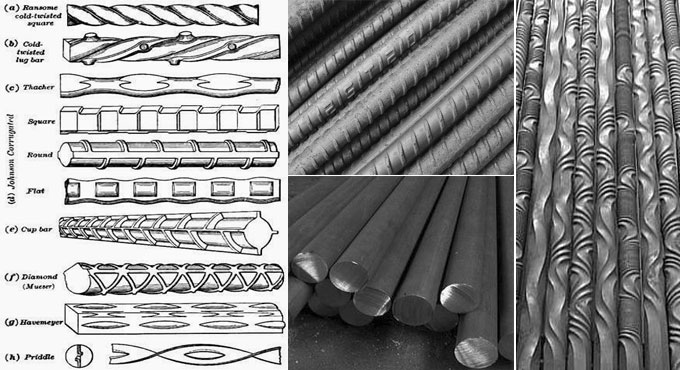
Types of steel bars for construction

Generally, the following four types of steel bars are utilized in concrete structure : Types of Steel Reinforcement used in Concrete Structures -
1. Hot Rolled Deformed Bars: It is extensively used in regular RCC structures. Hot rolling is performed in the mills by providing deformations on the surface i.e. ribs with the purpose of developing bond with concrete.
The stress - strain curve presents a separate yield point accompanied with a plastic stage in which strain is raised without raising the stress. It is succeeded by a strain hardening stage. It comprises of typical tensile yield strength of 60,000 psi.
2. Mild Steel Plain bars: These belong to plain bars and do not contain ribs on them. These are suitable for small projects where cost is a vital factor. Since the plain bars can?t be secured properly with concrete therefore hooks are arranged at the ends. In this type of steel, stress - strain curve also presents a separate yield point accompanied with a plastic stage in which strain is raised without raising the stress. It is succeeded by a strain hardening stage. Normal tensile yield strength is 40,000 psi.
3. Cold Worked Steel Reinforcement: Cold worked reinforcement is provided if hot rolled steel bar encounters process of cold working. Cold working is done by twisting or drawing the bars at room temperature. It properly reduces the Plastic Stage in the Stress-Strain curve, even though it provides more control on the size and tolerances of bars. As there is no plastic stage, ductility becomes lower as compared to Hot Rolled bars. It is mostly effective for the projects where low tolerances and straightness are vital factors.
The stress ? strain curve does not present a separate yield point since the plastic stage is completely discarded. Yield point is obtained by drawing a line parallel to the Tangent Modulus at 0.2% strain. Yield stress stands for the point where this line overlaps the stress ? strain curve.
It is defined as 0.2% proof stress. If yield stress is obtained at 0.1% strain it is defined as 0.1% proof stress. Normal tensile yield strength is 60,000 psi.
4. Prestressing Steel: Prestressing steel is applied in the form of bars or tendons which are constructed with several strands. The application of tendons / strands is very common since these can be easily placed in different profiles. Prestressing strands are built up with various wires (usually with 2, 3 or 7 wire strands). Normal seven wire strand comprises of six wires spun around the seventh wire with marginally a greater diameter, consequently a helical strand is created.
These wires are cold drawn and contain very high tensile ultimate strength (normally 250,000 - 270,000 psi). Due to extreme tensile strength, the concrete is prestressed properly even after experiencing short term and long term losses. These are applied as prestressed concrete in bridges or prestressed slabs in buildings. Prestressing steel also comes as non-bonded strands encased in PVC sheath. It is applied in Post-Tensioning of members. Prestressing strands can also be applied as Low Relaxation Strands which show low relaxation losses after prestressing. These are normally applied in prestressing members with large distances./p>
Because of cold drawing method, plastic stage in this type of steel is removed. Thus stress ? strain curve does not present a separate yield point. Yield point is obtained at 0.1% or 0.2% proof stress. The design of prestressed concrete is not based on yield stress rather it relies on the ultimate strength; therefore the property of interest in this type of steel is the ultimate strength.


